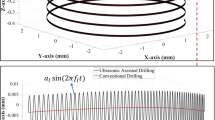Abstract
Machining with minimum quantity lubrication (MQL) is state of the art. Previous investigations were, however, concerned with tool optimisation and the surface quality of workpieces as well as coating technology. By now the same or partly better machining results than in conventional cutting with flood lubrication can be achieved due to adjusted tool geometries, workpiece materials and coatings. Tests about burr formation in short hole drilling exist for dry cutting or the machining with emulsion. This paper expands these results to the burr formation in machining with MQL.















Similar content being viewed by others
References
Feickert S, Weigold M, Hermenau U, Abele E (2004) Technologie und Umwelt–Widerspruch oder Ergänzung. Innovatives Zerspanen: effizient und umweltgerecht. VDI-Z Integrierte Produktion 146(9):54–57
Kühlschmierstoffe NN (1993) Hrsg.: Maschinenbau- und Kleineisenindustrie Berufsgenossenschaft, Düsseldorf, 3 Ausgabe
Kleber M, Lucas S, Ester I, Blaszekewicz M, Föllmann W, Bolt HM (2000) Toxikologische Aspekte bei der Verwendung von wassermischbaren Kühlschmierstoffen und Minimalmengenschmierungsstoffen. VDI Berichte 1532 Trockenbearbeitung: Drehen, Fräsen, Bohren. VDI Verlag, Düsseldorf
Klocke F, Lung D (2000) Minimalmengenkühlschmierung–Systeme, Werkzeuge und Medien. VDI Ber 1532:137–154
Konold T (2003) Es geht voran. Die Trockenbearbeitung ist mittlerweile prozesssicher und setzt sich immer mehr durch. MM Maschinenmarkt. Das IndustrieMagazin:70–72
Hänle P (2002) Entwicklung und Einsatzbeispiele neuer Werkzeuglösungen für die Bohrungsbearbeitung mit MMS. Schmalkalder Werkzeugtagung 6:1–4
Weinert K, Loichinger A (2002) Minimalmengenschmierung rotierender Werkzeuge. Analyse der Schmiermittelversorgung von Werkzeugen auf Bearbeitungszentren. VDI-Z Integrierte Produktion Special I Werkzeuge:27–30
Schneeweiss M, Schwarzburger R, Köhler S, Pospischil T (2004) Kühlschmierung bedarfsgerecht dosieren. WB Werkstatt Betrieb 137(11):54–58
Schäfer F (1976) Untersuchungen zur Gratbildung und zum Entgraten insbesondere beim Umfangsstirnfräsen, Dissertation Universität Stuttgart
Heisel U, Schaal M (2008) Kurzlochbohren mit Minimalmengenschmierung–Was kommt vorne an? ZWF Zeitschrift für wirtschaftlichen Fabrikbetrieb 103(9):564–567
Aurich JC (2006) SpanSauber. Untersuchung zur Beherrschung der Sauberkeit von zerspanend hergestellten Bauteilen, Ergebnisworkshop, Lehrstuhl für Fertigungstechnik und Betriebsorganisation, Technische Universität Kaiserslautern
Dornfeld D, Min S, Reich-Weiser C (2004) Burr formation, deburring and surface finishing. Seventh international conference on deburring and surface finishing, Berkeley
Luik M (2007) Gratbildung und Gratminimierung bei asymmetrisch mit Hartmetall-Wendeschneidplatten bestückten Bohrwerkzeugen. Dissertation, Universität Stuttgart
Schulte K (2000) Stahlbearbeitung mit Wendeschneidplatten-Bohrern bei reduziertem Kühlschmierstoff-Durchsatz. Dissertation, ISF Dortmund
Heisel U, Schaal M, Wolf G (2008) Burr formation in milling with minimum quantity lubrication. Production Engineering (in press)
Heisel U, Schaal M (2008) Gratbildung beim Drehen mit Minimalmengenschmierung. wt Werkstatts-technik online 98(5):363–369
Acknowledgments
This research was conducted within the framework of a project supported by the German Research Foundation (DFG).
Author information
Authors and Affiliations
Corresponding author
Rights and permissions
About this article
Cite this article
Heisel, U., Schaal, M. Burr formation in short hole drilling with minimum quantity lubrication. Prod. Eng. Res. Devel. 3, 157–163 (2009). https://doi.org/10.1007/s11740-009-0153-5
Received:
Accepted:
Published:
Issue Date:
DOI: https://doi.org/10.1007/s11740-009-0153-5




